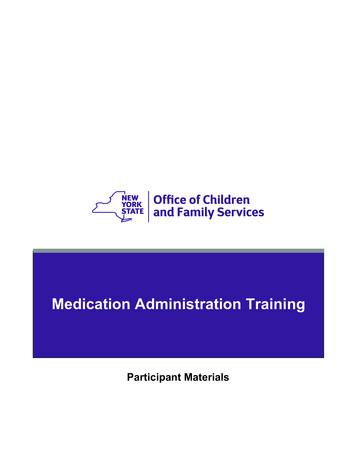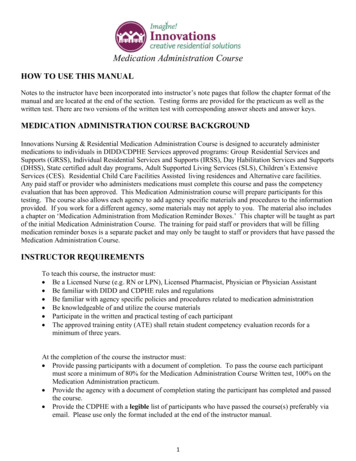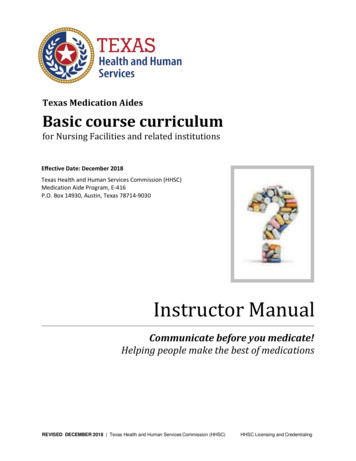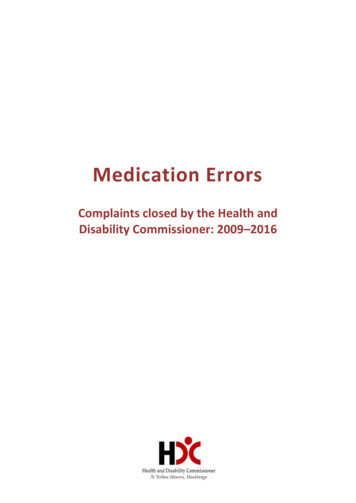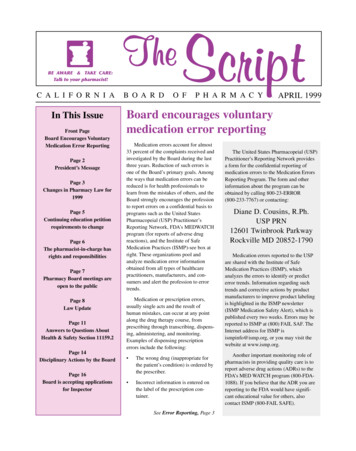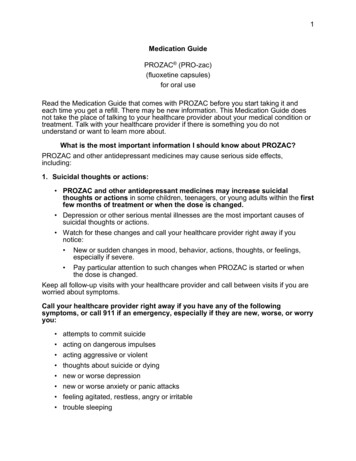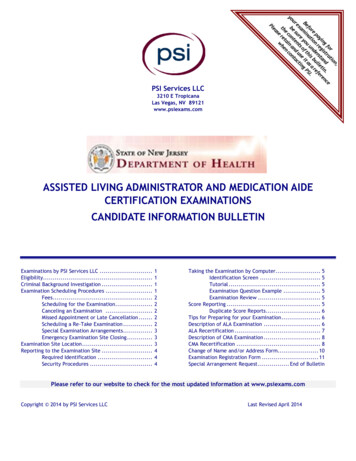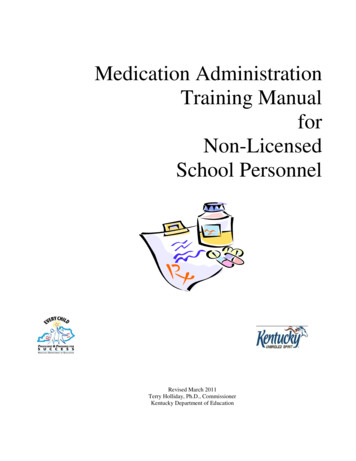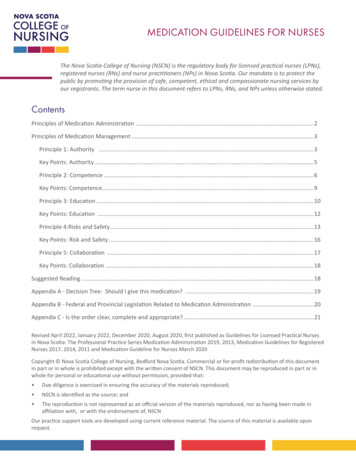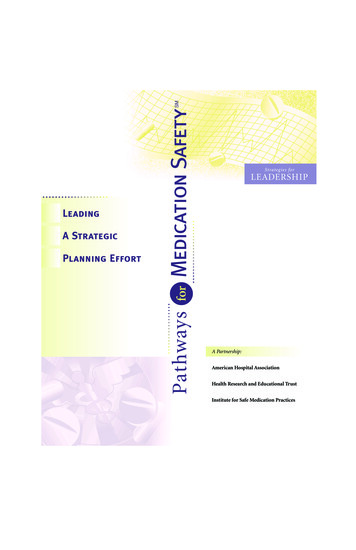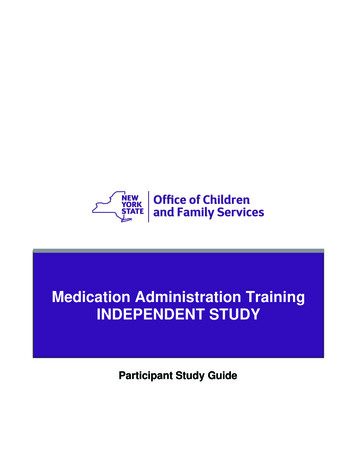
Transcription
Medication Administration TrainingINDEPENDENT STUDYParticipant Study Guide
This document is provided under a contractual agreement between theNew York State Office of Children and Family ServicesDivision of AdministrationBureau of Training and DevelopmentANDProfessional Development ProgramRockefeller CollegeUniversity at AlbanyState University of New YorkAcknowledgementThis material was developed by the Professional Development Program, Rockefeller College,University at Albany, under a training and administrative services agreement with the New YorkState Office of Children and Family Services.DisclaimerWhile every effort has been made to provide accurate and complete information, the Office ofChildren and Family Services and the State of New York assumes no responsibility for any errorsor omissions in the information provided here and makes no representations or warranties aboutthe suitability of the information contained here for any purpose. All information and documents areprovided “as is,” without a warranty of any kind.Copyright 2016 by The New York State Office of Children and Family Services
Medication Administration Training (MAT)Independent StudyParticipant Study GuideTABLE OF CONTENTSMedication Administration Training (MAT) Independent Study Overview. 1Module 1: An Introduction to Medication Administration Training. 7Module 2: The Five Rights of Safe Medication Administration. 8Module 3: Medication Overview. 9Module 4: Handling of Medication.11Module 5: Safe Medication Administration. 13Module 6: Safety Precautions Related to Medication Administration . 14Module 7: Preparation and Administration Techniques . 15Module 8: Asthma . 17Module 9: Emergency Care. 18Module 10: Special Situations. 20Module 11: Conclusion. 22Medication Administration Training (MAT) Independent Study Participant Study Guide (rev Mar 2016)Page i
This page is intentionally blank
Medication Administration Training (MAT)Independent Study OverviewOverviewCaring for children is a rewarding and demanding profession. You work hard to develop a caring andtrusting relationship with the children in your program. To provide the best care, you learn techniques andstrategies for offering a nurturing and responsive environment for children. Part of this care may includegiving medication to help children maintain or regain their health.The Medication Administration Training (MAT) course is a skills-based training to help you give medicationsafely in your program. The course is eight (8) hours of training and includes information on video andhands-on demonstrations.The training provides an overview of medication effects and ways to give both over-the-counter andprescription medication; safe handling, storage and disposal of medication; permission and instructionrequirements; preparation and administration techniques; asthma information; and instruction regardingemergency care and special situations.You are eligible to complete the MAT course if you are:(a) a child day care provider whose program is licensed or registered by the New York State Officeof Children and Family Services (OCFS); or(b) an employee of an OCFS-licensed group family day care or day care center program OR anemployee of an OCFS-registered family day care, school-age child care or small day carecenter program; or(c) a legally exempt provider serving children whose care is funded through public child caresubsidy.To obtain your MAT certificate, you can complete the MAT course in two ways: through classroominstruction or independent study. This guide is for providers who are interested in completing the course byindependent study. If you would like more information about completing the MAT course through classroominstruction, visit www.ecetp.pdp.albany.edu.MAT Independent StudyThe Medication Administration Training (MAT) Independent Study course is comprised of two parts. PartOne is a self-paced review of the MAT course content, using handouts, video segments and independentexercises. Part Two consists of hands-on practice time and testing with an approved MAT Trainer.Part One: ContentThe MAT course consists of eleven modules, ranging from medication effects to safe medicationadministration. The material for each of these modules is available for download from the MATProgram website: www.ecetp.pdp.albany.edu/mat.shtm.Medication Administration Training (MAT) Independent Study Participant Study Guide (rev Mar 2016)Page 1
Part Two: Practice and TestingOnce you have reviewed all of the MAT course content in Part One, you must completetesting in order to receive a MAT certificate. You will complete a written test and three (3) skillsdemonstrations (random skills competency, liquid measuring competency, and epinephrineauto‑injector [EpiPen or Auvi-Q ] skills competency). This part of MAT Independent Study iscompleted in a classroom with an approved MAT Trainer. Before you are tested, you will have timeto practice all of the skills you studied with an approved MAT Trainer and ask questions.Medication Administration Training (MAT) Independent Study Participant Study Guide (rev Mar 2016)Page 2
Medication Administration Training (MAT)Independent StudyPART ONEMedication Administration Training (MAT) Independent Study Participant Study Guide (rev Mar 2016)Page 3
This page is intentionally blank
Part OneOne of the most notable benefits of the MAT Independent Study course is the opportunity to study the MATmaterials on your own, at your own pace. The MAT course content is divided into these training modules: Introduction Module 1: An Introduction to Medication Administration Training Module 2: The Five Rights of Safe Medication Administration Module 3: Medication Overview Module 4: Handling of Medication Module 5: Safe Medication Administration Module 6: Safety Precautions Related to Medication Administration Module 7: Preparation and Administration Techniques Module 8: Asthma Module 9: Emergency Care Module 10: Special Situations Module 11: ConclusionCompleting Part One of MAT Independent StudyBe sure to read this study guide as you complete each training module. Since each module builds uponinformation covered in the previous modules, it is important for you to complete the modules in order.When you start a module, make sure you have all the handouts. Each module includes at least one videocomponent, so you need to have access to your computer while reviewing the handouts.Medication Administration Training (MAT) Independent Study Participant Study Guide (rev Mar 2016)Page 5
This page is intentionally blank
Module 1:An Introduction to Medication Administration TrainingThis module provides an overview of the MAT course and who is required to take the training.Materials NeededParticipant Materials: Handout 1.1: Medication Administration Training (MAT) Resource Materials Handout 1.2: Medication Administration Training (MAT) Overview Handout 1.3: GlossaryVideo: Video Segment #1: “Introduction”Additional Resources: New York State OCFS Child Day CareRegulations for your modality of care Health care plan template for yourmodality of careThese resource materials are availablefor download from the OCFS website:http://ocfs.ny.gov/main/childcare/daycare regulations.aspInstructions1. Review Handout 1.1: Medication Administration Training (MAT) Resource Materials.2. Watch video segment #1: “Introduction.”3. Refer to the OCFS regulations and health care plan for your modality of care as resources duringthis training.4. Review the following handouts: Handout 1.2: Medication Administration Training (MAT) Overview Handout 1.3: GlossaryMedication Administration Training (MAT) Independent Study Participant Study Guide (rev Mar 2016)Page 7
Module 2:The Five Rights of Safe Medication AdministrationThis module explains the Five Rights, how to match them correctly at least three times when givingmedication, and how to avoid medication errors.At the end of this module, you will be able to:Ø describe the Five Rights of safe medication administration.Materials NeededParticipant Materials: Video:Handout 2.1: What Are the Five Rights?Handout 2.2: Matching the Five RightsHandout 2.3: OCFS Written Medication Consent FormExercise 2.1: Finding the Five RightsAnswer Key 2.1: Finding the Five Rights Video Segment #2: “The ‘Five Rights’”Instructions1. Review the following handouts: Handout 2.1: What Are the Five Rights? Handout 2.2: Matching the Five Rights2. Watch video segment #2: “The ‘Five Rights’.”3. Review Handout 2.3: OCFS Written Medication Consent Form.4. Review where the Five Rights are located on the OCFS Written Medication Consent Form.5. Complete Exercise 2.1: Finding the Five Rights.6. Review Answer Key 2.1: Finding the Five Rights to check your answers. If you answered any partof the exercise incorrectly, review the corresponding handout(s) to reinforce the correct information.Consider how you willhandle needing to administermultiple medications thatare due at the same time.Medication can safely be givenup to 30 minutes before or up to30 minutes after the dose is due,so good planning is essential.Medication Administration Training (MAT) Independent Study Participant Study Guide (rev Mar 2016)Page 8
Module 3:Medication OverviewThis module provides an overview of medication use. Topics include desired and undesired effects ofmedication; the seven (7) routes of medication administration covered in the MAT course and a descriptionof the medication absorption for each route; categories of medication and how to differentiate betweenprescription and over-the-counter medication, as well as generic and brand name medication; and howmedication can interact with food and with other medication.At the end of this module, you will be able to:ØØØØØØØidentify reasons why children are given medication;identify undesired effects of medication and how to respond to each effect;list the seven (7) medication routes covered in the MAT course;identify the three (3) medication routes not covered in this course;identify and define common over-the-counter medication;identify and define common prescription medication; andidentify and define common generic and brand name medication.Materials NeededParticipant Materials: Video:Handout 3.1: Medication EffectsHandout 3.2: Medication RoutesHandout 3.3: Overview of the Medication Routes Covered in the MAT CourseHandout 3.4: Types of MedicationExercise 3.1: Handling Effects from MedicationExercise 3.2: Identifying Types of MedicationAnswer Key 3.1: Handling Effects from MedicationAnswer Key 3.2: Identifying Types of Medication Video Segment #3: “Medication Effects’” Video Segment #4: “Medication Routes” Video Segment #5: “Medication Types”Instructions1. Review Handout 3.1: Medication Effects.Refer to Handout 1.3: Glossaryif you’re unfamiliar with anyof the terms in the training.2. Watch video segment #3: “Medication Effects.”3. Complete Exercise 3.1: Handling Effects from Medication.4. Review Answer Key 3.1: Handling Effects from Medication to check your answers. If youanswered any part of the exercise incorrectly, review the corresponding handout(s) to reinforce thecorrect information.Medication Administration Training (MAT) Independent Study Participant Study Guide (rev Mar 2016)Page 9
5. Review the following handouts: Handout 3.2: Medication Routes Handout 3.3: Overview of the Medication Routes Covered in the MAT Course6. Watch video segment #4: “Medication Routes.”7. Review Handout 3.4: Types of Medication.8. Watch video segment #5: “Medication Types.”9. Complete Exercise 3.2: Identifying Types of Medication.10. Review Answer Key 3.2: Identifying Types of Medication to check your answers. If youanswered any part of the exercise incorrectly, review the corresponding handout(s) to reinforce thecorrect information.Medication Administration Training (MAT) Independent Study Participant Study Guide (rev Mar 2016)Page 10
Module 4:Handling of MedicationThis module covers the handling and preparation needed before giving medication.At the end of this module, you will be able to:Ø identify the permissions and instructions needed to administer prescription medication to children inyour care;Ø identify the permissions and instructions needed to administer over-the-counter medication tochildren in your care;Ø identify the items needed for medication instructions from the licensed authorized prescriber;Ø identify the required elements on a prescription medication label;Ø identify common medical abbreviations;Ø identify the necessary items that must be documented for each medication given;Ø identify how to receive medication safely from parents;Ø describe the optimal conditions for storing most medication;Ø explain how to safely store medication that requires refrigeration;Ø identify how to store controlled substances; andØ explain how to safely handle unused, expired, or discontinued medication.Materials NeededParticipant Materials:Video: Handout 4.1: What Permissions and Instructions Do I Need to Give Medication?Handout 4.2: OCFS Written Medication Consent FormHandout 4.3: Common Medical AbbreviationsHandout 4.4: OCFS Log of Medication AdministrationHandout 4.5: Good DocumentationHandout 4.6: OCFS Verbal Medication Consent Form and Log of AdministrationHandout 4.7: Medication StorageHandout 4.8: Accepting MedicationHandout 4.9: Administration Tools and Medication Label RequirementsHandout 4.10: Medication Label Does Not Match Consent FormHandout 4.11: Planning Your DayExercise 4.1: Accepting MedicationAnswer Key 4.1: Accepting Medication Video Segment #6: “Permissions, Instructions and Documentation”Video Segment #7: “Permission and Instructions Exceptions”Video Segment #8: “Handling, Storage and Disposal”Video Segment #9: “Medication Routine”Medication Administration Training (MAT) Independent Study Participant Study Guide (rev Mar 2016)Page 11
Instructions1. Review the following handouts: Handout 4.1: What Permissions and Instructions Do I Need to Give Medication? Handout 4.2: OCFS Written Medication Consent Form Handout 4.3: Common Medical Abbreviations Handout 4.4: OCFS Log of Medication Administration Handout 4.5: Good Documentation2. Watch video segment #6: “Permissions, Instructions and Documentation.”3. Review the following handouts: Handout 4.6: OCFS Verbal Medication Consent Form and Log of Administration4. Watch video segment #7: “Permission and Instructions Exceptions.”5. Review the following handouts: Handout 4.7: Medication Storage6. Watch video segment #8: “Handling, Storage and Disposal.”7. Review the following handouts: Handout 4.8: Accepting Medication Handout 4.9: Administration Tools and Medication Label Requirements Handout 4.10: Medication Label Does Not Match Consent Form Handout 4.11: Planning Your Day8. Watch video segment #9: “Medication Routine.”9. Complete Exercise 4.1: Accepting Medication.10. Review Answer Key 4.1: Accepting Medication to check your answers. If you answered any partof the exercise incorrectly, review the corresponding handout(s) to reinforce the correct information.If a parent asks you to give herbalmedication or other remedies to treat achild, get the required permission andinstructions based on the way (route)the herbal medication is given.If you are concerned about giving herbalmedication, discuss your concerns withthe child’s parent and your program’sHealth Care Consultant.Parents can ask the pharmacy tosplit the child’s medication into twocontainers, each of which must beproperly labeled.Remember that for over‑the‑countermedication being administered tochildren who are 18 months of age oryounger, written health care providerinstructions are required if the parent’sinstructions do not match package directions.Medication Administration Training (MAT) Independent Study Participant Study Guide (rev Mar 2016)Page 12
Module 5:Safe Medication AdministrationThis module discusses giving medication to children, including ill or uncooperative children, and how to givemedication safely.At the end of this module, you will be able to:Ø describe age-appropriate techniques to use when giving medication to a non-mobile infant as wellas to a mobile infant;Ø describe age-appropriate techniques to use when giving medication to a toddler;Ø describe age-appropriate techniques to use when giving medication to a preschooler;Ø describe age-appropriate techniques to use when giving medication to a school-age child;Ø describe techniques that are not appropriate to use when administering medication to children;Ø explain the appropriate procedure to follow if a medication is not taken in its complete form; andØ explain what to do if an infant or child will not take the medication.Materials NeededParticipant Materials: Handout 5.1: Giving Medication to Children Handout 5.2: Special Situations Handout 5.3: Giving Medication SafelyVideo: Video Segment #10: “Giving Medication to Children, Including Ill orUncooperative Children” Video Segment #11: “Giving Medication Safely”Instructions1. Review the following handouts: Handout 5.1: Giving Medication to Children Handout 5.2: Special Situations2. Watch video segment #10: “Giving Medication toChildren, Including Ill or Uncooperative Children.”3. Review Handout 5.3: Giving Medication Safely.4. Watch video segment #11: “Giving MedicationSafely.”In addition to comfort level, it isimportant to be aware of any specialconcerns families and childrenhave based on cultural practicesfor taking medication.If you have questions concerning the bestpractice techniques, work with your program’sHealth Care Consultant and the child’s healthcare provider to determine how best toadminister the medication safely.Medication Administration Training (MAT) Independent Study Participant Study Guide (rev Mar 2016)Page 13
Module 6:Safety Precautions Related toMedication AdministrationThis module discusses safety precautions to consider—including proper hand washing and glove use—when giving medication.At the end of this module, you will be able to:Ø explain the steps of appropriate hand washing for administering medication; andØ describe the correct procedures for putting on, removing, and disposing of gloves.Materials NeededParticipant Materials: Handout 6.1: Hand Washing Handout 6.2: Using Gloves Handout 6.3: Cleaning and SanitizingVideo: Video Segment #12: “Hand Washing” Video Segment #13: “Safety Precautions for Medication Administration”Instructions1. Review Handout 6.1: Hand Washing.2. Watch video segment #12: “Hand Washing.”3. Review the following handouts: Handout 6.2: Using Gloves Handout 6.3: Cleaning and Sanitizing4. Watch video segment #13: “Safety Procedures for Medication Administration.”Medication Administration Training (MAT) Independent Study Participant Study Guide (rev Mar 2016)Page 14
Module 7:Preparation and Administration TechniquesThis module describes the step-by-step process for giving medication by specific routes. You will berequired to perform a competency-based skills demonstration (in Part Two, with an approved MAT Trainer)of the material covered in this module. This module also reviews the use of a nebulizer machine toadminister medication to children.At the end of this module, you will be able to:Ø demonstrate your ability to administer medication correctly by one of the following routes—oral, topical, medicated patches, inhaled, in the eye or in the ear;Ø demonstrate how to measure the correct dose of medication using one of the following tools—a liquid medicine cup, dosing spoon or oral medication syringe;Ø explain why medication-related equipment supplies must be kept clean;Ø describe the cleaning techniques for medicine tools, metered-dose inhalers and nebulizermachines;Ø identify how to appropriately set up a nebulizer machine using the manufacturer’s instructions; andØ identify how to administer medication using a nebulizer machine by following the manufacturer’sinstructions.Materials NeededParticipant Materials: Video:Handout 7.1: Applying Medication TopicallyHandout 7.2: Applying Medicated PatchesHandout 7.3: Giving Medication by MouthHandout 7.4: Measuring Liquid MedicationHandout 7.5: Giving Medication Inhaled by MouthHandout 7.6: Giving Medication Inhaled Through the NoseHandout 7.7: Giving Medication in the EyeHandout 7.8: Giving Medication in the EarSkills Practice 7.1: Giving Liquid by MouthSkills Practice 7.2: Oral Liquid Consent FormSkills Practice 7.3: Skills Practice LogSkills Practice 7.4: Pharmacy Print-Out—AmoxicillinSkills Practice 7.5: Evaluation Chart for Skills DemonstrationSkills Practice 7.6: Tools—Matching the Five RightsSkills Practice 7.6: Tools—Giving Medication SafelySkills Practice 7.6: Tools—Measuring Liquid Medication Video Segment #14: “Applying Topical Medication, Medicated Patches, and GivingMedication by Mouth”Medication Administration Training (MAT) Independent Study Participant Study Guide (rev Mar 2016)Page 15
Video Segment #15: “Inhaled Medication” Video Segment #16: “Eye and Ear Medication” Video Segment #17: “Practice Skills Demonstration”Instructions1. Review the following handouts: Handout 7.1: Applying Medication Topically Handout 7.2: Applying Medicated Patches Handout 7.3: Giving Medication by Mouth Handout 7.4: Measuring Liquid Medication2. Watch video segment #14: “Applying Topical Medication, Medicated Patches and GivingMedication by Mouth.”3. Review the following handouts: Handout 7.5: Giving Medication Inhaled by Mouth Handout 7.6: Giving Medication Inhaled Through the Nose4. Watch video segment #15: “Inhaled Medication.”5. Review the following handouts: Handout 7.7: Giving Medication in the Eye Handout 7.8: Giving Medication in the Ear6. Watch video segment #16: “Eye and Ear Medication.”7. The MAT Participant Materials include Skills Practice 7.1 through Skills Practice 7.6 andvideo segment #17: “Practice Skills Demonstration.” This information is included to enable you tofamiliarize yourself with the information. If you have any questions about the skills practice, speakwith your MAT Trainer during Part Two of MAT Independent Study.8. You will have time to practice using a nebulizer machine during Part Two. You will not be requiredto demonstrate this administration technique.Medication Administration Training (MAT) Independent Study Participant Study Guide (rev Mar 2016)Page 16
Module 8:AsthmaThis module provides you with information for safely and effectively caring for a child who has asthma.Topics include an overview of asthma, the use of an asthma care plan, and the basics of how to use andmaintain a nebulizer machine.At the end of this module, you will be able to:identify asthma “early warning signs”;identify common asthma triggers;identify measures to prevent an asthma episode;explain the reasons for using a nebulizer machine;identify how to set up a nebulizer machine appropriately, using the manufacturer’s instructions;identify how to administer medication using a nebulizer machine by following the manufacturer’sinstructions; andØ describe the appropriate process for cleaning a nebulizer machine after each use.ØØØØØØMaterials NeededParticipant Materials: Video:Handout 8.1: Asthma FactsHandout 8.2: Asthma TreatmentHandout 8.3: Example of a Care Plan for a Child with AsthmaHandout 8.4: New York State Department of Health Asthma Action Plan Video Segment #18: “What Is Asthma?”Instructions1. Review the following handouts: Handout 8.1: Asthma Facts Handout 8.2: Asthma Treatment2. Watch video segment #18: “What Is Asthma?”3. Review the following handouts: Handout 8.3: Example of a Care Plan for a Child with Asthma Handout 8.4: New York State Department of Health Asthma Action PlanMedication Administration Training (MAT) Independent Study Participant Study Guide (rev Mar 2016)Page 17
Module 9:Emergency CareThis module discusses responding to specific situations that require emergency care. Topics includeunintentional medication poisoning, stocking a first aid kit, storing non-child specific over-the-countermedication, recognizing anaphylaxis, and administering an epinephrine auto-injector in the event of asevere allergic reaction.At the end of this module, you will be able to:explain the potential danger of unintentional medication ingestion and exposure;describe how to prevent unintentional poisoning from medication in a child care setting;describe the appropriate actions to take in the event of an unintentional medication poisoning;identify the symptoms of anaphylaxis;explain when you need to call 911 or other first responder in your area;identify the permissions needed to administer an epinephrine auto-injector device;explain how to appropriately store an epinephrine auto-injector device, specifically an EpiPen orAuvi-Q ; andØ explain how to correctly administer an epinephrine auto-injector device, specifically an EpiPen orAuvi-Q .ØØØØØØØMaterials NeededParticipant Materials:Video: Handout 9.1: Prevention of UnintentionalMedication Poisoning Handout 9.2: Anaphylaxis Handout 9.3: Epinephrine Auto-Injector(EpiPen or Auvi-Q ) Use and Storage Video Segment #19: “UnintentionalMedication Poisoning” Video Segment #20: “Anaphylaxis”Instructions1. Review Handout 9.1: Prevention ofUnintentional Medication Poisoning.2. Watch video segment #19: “UnintentionalMedication Poisoning.”Whenever using an epinephrineauto-injector remember to call 911immediately after administeringthe medication (or, if you work withother providers, have one of themcall 911 while you administer theepinephrine auto-injector).It is standard protocol to send the usedepinephrine auto-injector with the childon the ambulance.Some children might have anepinephrine auto‑injector 2‑Pak,which has two epinephrineauto‑injectors in the box. This isso you have another epinephrineauto‑injector available in caseemergency care cannot arrive quickly.If a child in your program has anepinephrine auto-injector 2-Pak, makesure you know if and when you shouldgive the second dose.Medication Administration Training (MAT) Independent Study Participant Study Guide (rev Mar 2016)Page 18
3. Review the following handouts: Handout 9.2: Anaphylaxis Handout 9.3: Epinephrine Auto-Injector (EpiPen or Auvi-Q ) Use and Storage4. Watch video segment #20: “Anaphylaxis.”Medication Administration Training (MAT) Independent Study Participant Study Guide (rev Mar 2016)Page 19
Module 10:Special SituationsThis module discusses special situations that may arise when administering medication to children in achild care setting. Topics include medication errors, issues to consider for allowing a child to administermedication independently in a child care setting, children with special health care needs, and things toconsider regarding medication administration on a field trip.At the end of this module, you will be able to:ØØØØØØØØØidentify medication errors;explain the steps to follow if a medication error occurs;explain the appropriate action to take if a medication is not given;describe independent medication administration;explain the appropriate process to follow if the program would like to allow a child to administermedication independently;explain the process for administering medication away from the program site;explain how to safely transport medication (including medication that requires refrigeration) whenaway from the program site;describe how to document medication that is administered away from the program site; andidentify the components that should be included in the program’s field trip plan (as it relates tomedication administration) when going off-site.Materials NeededParticipant Materials: Handout 10.1: Medication ErrorsHandout 10.2: OCFS Medication Error Report FormHandout 10.3: Independent Medication AdministrationHandout 10.4: Children with Special Health Care NeedsHandout 10.5: OCFS Individual Health Care Plan for a Child with Special HealthCare Needs Handout 10.6: Giving Medication when Away from the Program Handout 10.7: First Aid KitVideo: Video Segment #21: “Medication Errors”Video Segment #22: “Independent Medication Administration”Video Segment #23: “Children with Special Health Care Needs”Video Segment #24: “Giving Medication when Away from the Program”Medication Administration Training (MAT) Independent Study Participant Study Guide (rev Mar 2016)Page 20
Instructions1. Review the following handouts: Handout 10.1: Medication Errors Handout 10.2: OCFS Medication Error Report Form2. Watch video segment #21: “Medication Errors.”3. Review Handout 10.3: Independent Medication Administration.4. Watch video segment #22: “Independent Medication Administration.”5. Review the following handouts: Handout 10.4: Children with Special Health Care Needs Handout 10.5: OCFS Individual Health Care Plan for a Child with Special HealthCare Needs6. Watch video segment #23: “Children with Special Health Care Needs.”7. Review the following h
Medication Administration Training (MAT) Independent Study Participant Study Guide (rev Mar 2016) Page 5 Part One One of the most notable benefits of the MAT Independent Study course is the opportunity to study the MAT materials on your own, at your own pace. The MAT course conte
